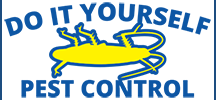 Loading... Please wait...
Loading... Please wait...Categories
Our Newsletter
- Home
- Pests
- Insect Pests
- Bees
- Honey Bees
Honey Bees
Honey Bees, Yellow Jackets, Honey Bee Control, Hornets, Wasps, Cicada Killers, Mud Daubers, Bees, and Bumble Bee Sprays
|
BALDFACED HORNETS
The Bald faced hornet (Dolichovespula maculata) is sometimes called the white-faced hornet, but is actually a yellowjacket. It's easy to spot since it's our only black and white yellow jacket. Its nest is a gray "paper" envelope with several layers of combs inside. A mature nest is bigger than a basketball, but pear-shaped, with the larger end at the top and an entrance hole near the bottom.
A single, over-wintering queen begins building the nest in the spring. She lays eggs and tends the first batch of larvae that develop into workers. These workers tend new larvae and expand the nest throughout the summer. A mature colony can have several hundred workers by the end of the summer. In fall, workers die and next year's queens find over-wintering sites.
Baldfaced hornets are beneficial, capturing insects (often including other yellowjackets) to feed to their larvae. Though larger than other yellowjackets, Baldfaced hornets are generally more docile. But they can become aggressive and will sting when their nest is disturbed or threatened.
A Baldfaced nest is usually constructed high in a tree. In these cases the nest is best left alone. In fact, Baldfaced hornet nests are often first noticed in fall when leaves drop, exposing the nest. By this time the hornets are dead or dying, and the nest will not be reused.
Occasionally you will find a Baldfaced nest built on the side of a building, in low shrubbery, or even in an attic or shed. Nests in these sited will probably need to be eliminated.
Bald Faced Hornet Elimination
-
Treat the hornet nest as late in the evening as possible. Remember that all wasps, hornets and bees are at rest when it is dark. Not only will all the hornets be in the nest for you to exterminate (instead of foraging for food some distance away) , you will be at far less risk when they are resting. No one wants to treat a hornets' nest with hornets dive-bombing their head!
-
When approaching the nest, move slowly so as not to disturb the sleeping pests. If eliminating the nest in late evening is not possible (forcing you to work in broad daylight), avoid crossing the obvious flight path. You also do not want to cast a shadow across the nest while you work.
-
For initial "knockdown" or quick kill, use a professional wasp freeze aerosol. This will enable you to attack the nest from a distance or reach higher areas without the use of a ladder. The wasp freeze should first be directed at the entrance of the nest to eliminate any guard wasps. Next, thoroughly soak the remainder of the nest. For the average size nest (or larger) you will need two cans of wasp freeze. These types of aerosol are not very expensive and you do not want to run out of product in the middle of the job!
-
You can now finish the hornet elimination. This is best done using Drione Dust or Delta Dust. Either one of these products will do an excellent job, and they also are packaged in a container that allows you to apply the dust directly. Ease the tip of your dust container (or Crusader Duster, if you prefer) into the entrance and quickly squeeze three or four times. This will send the pesticide dust far into the galleries, where it will remain long enough to kill all hornets.
-
After 24 to 48 hours, all hornets should be dead. (If not, you simply repeat the dust application). You can now safely remove the empty nest.
-
Honey Bees and Yellow Jackets nesting inside walls are best treated with Drione Dust or Delta Dust, squeezing the dust inside the entry points inside the building.
-
To spray small wasp or hornet nests use a solution of Viper before the sun rises in the morning. Thoroughly wet down the nest while all the wasps are sitting on the nest.
-
To treat Yellow Jackets or Bumble Bees nesting in the ground use a solution of Viper mixed in a bucket. Apply 2-4 gallons of Sniper solution in each nest, depending on the size, before sunrise while all the Yellow Jackets or Bumble Bees are sleeping.
Follow these links to order your Honey Bee Control products:
